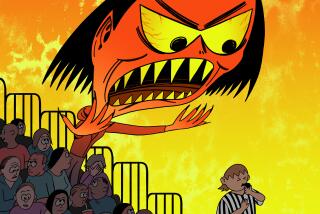When going back to school causes a real headache
- Share via
If your children aren’t back to school already, they’re probably pretty close, and dreading it as much as you’re anticipating quiet mornings once they’re in the classroom again.
The back-to-school flood of books started midsummer with various titles on keys to student success, the virtues of home schooling, and true tales of classroom adversity and fighting school bureaucracy.
But what grabbed my attention this year weren’t the books about the educational side: The titles about the sports side of our children’s school careers -- and keeping them safe on the field -- had me a little anxious.
Former Oakland Raiders quarterback Ken Stabler might be the latest player to sue the NFL over head injuries, but Robert Cantu’s “Concussions and Our Kids” and Rosemarie Scolaro Moser’s “Ahead of the Game” are strong reminders that brain trauma and serious injury aren’t exclusive to adult sports.
The image on each book cover shows child football players, but the gridiron -- which both authors devote plenty of time to discussing -- isn’t the only place where head traumas happen. For obvious reasons, soccer is risky when kids try heading the ball; so is basketball, when a loose ball can turn the game into a rugby match.
My 9-year-old is in Little League and complains that his helmet is uncomfortable: He tries to ditch it once he gets on base. But Cantu’s account of one poor kid getting beaned in the temple as he rounded third base -- he developed a huge blood clot behind his right eye -- is enough to make me want to glue that helmet to his head.
Does that mean kids shouldn’t play school sports? Of course not. Just don’t forget the risks, both authors argue. Scolaro Moser’s book even provides parents with the steps for deciding if their child should return to sports after having a head injury. A must-read for sports families.
Another must-read for any coach on the field or sports medical staff, whether working with kids or adults, is “Emergencies in Sports Medicine.” Editors Julian Redhead and Jonathan Gordon have done a superb job of categorizing and highlighting the many types of calamities on the field and how to quickly handle them.
It’s more than just a catalog of fixes, though: What I like is how this compact book, with a soft cover making it easy to slip into your back pocket, also gives a broader, bigger picture of how to react if it’s your job to keep players healthy during a game.
In their introduction, Redhead and Gordon even throw in a bit of humor, which tips off readers to their British backgrounds along with those of their distinguished contributors, who hold posts at medical centers and schools from Glasgow to London:
“Imagine trying to carry a 16-stone rugby player with a badly sprained ankle ... to the warmth of the nearest dressing room,” they write, with a wry tone, “and one soon understands the importance of assistance with transport.”
It doesn’t matter where sporting events take place or at what level -- children, adult, professional. When it comes to sports, these editors remind us, there really is no such thing as “child’s play.” A smart, concise addition to your shelf of athletics-themed books.
More to Read
Sign up for our Book Club newsletter
Get the latest news, events and more from the Los Angeles Times Book Club, and help us get L.A. reading and talking.
You may occasionally receive promotional content from the Los Angeles Times.










